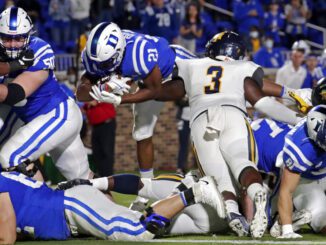It’s likely one of the first things fans at a college football game will notice. Then, as the action on the field begins, it’s forgotten just as quickly.
On the sideline, right at the 50-yard line, each team has a colorful mat, adorned with numbered dots.
They’re not seen in the NFL, but just about every college team — Clemson is a notable exception — has one at midfield.
Obviously, giving the prime real estate it occupies, the mat must have an important role in game day operations. Yet the vast majority of time that play is going on, it sits, empty and unused.
“It’s called the Launch Pad,” said Duke special teams coach Kirk Benedict. “And it’s a sacred spot on the sideline.”
While playcalling and signaling has gotten more and more complex over the years, complete with decoy signal callers and large posterboard signs to flash at the players on the field, the Launch Pad’s purpose is simple and basic — first day of Pop Warner practice basic.
There are 11 dots. Each player on special teams stands on a dot — to make sure that the correct number of players go onto the field for kicks and punts.
“You want to make sure you have 11 guys before you send them out,” said North Carolina special teams coach Luke Paschall.
That’s it.
Each team has its own variation on the mat. Duke doesn’t use one for home games. Instead, the Blue Devils have the dots and numbers painted right on the turf at Wallace Wade in permanent paint. So it doesn’t have to be redone each game, like the field.
“With a mat, you typically have to hold it down with stakes,” Benedict said. “Or it will get kicked around or blown around. Since we have turf on our sidelines, we don’t want to be sticking stakes into it.”
Duke does have a mat that it brings to road games.
They also only use 10 dots, instead of 11. The players line up in two rows of five, and, depending on which play is upcoming, the kicker, punter or return man stands in front, dotless.
“Each player has an assigned number to report to, based on their role on special teams,” Benedict explained. “That makes it easy for us to take roll and see who’s missing.”
At North Carolina, there are three rows of dots — the back row has just three, instead of four.
The Tar Heels also only use it for kickoffs and kick returns.
“It’s harder to do it for punts and punt returns,” said Paschall, “because you have to travel with the ball. If you’re punting from the 10, you can’t run to the 50 to get lined up and then go onto the field.”
While offenses and defenses have several downs to talk to coaches in the press box, look at photos of play formations and get coaching, everything on special teams is accelerated. So the Launch Pad is also used as the bench area for special teams. It’s not just a place where they line up to take attendance.
“We have the ones line up on the dots and have their backups surrounding them,” said Paschall. “That way if there are any corrections or changes, we don’t have to coach two groups separately. Then, if there’s an injury later in the game and someone has to go in, they’ll know what’s going on.”
Duke does something similar.
“Jacob Morgenstern always comes to the pad,” said Benedict, “even if he’s not on that particular special team. So does Mason Williams. That way, if something happens, we can throw them in at a position they’ve never practiced before.”
There is one area where the Launch Pad’s power to organize breaks down: Many of the players who will participate in a punt or kick may already be on the field, playing on offense or defense, when the rest of the team gathers at the mat.
Not surprisingly, that’s usually where the problems occur.
“It’s player awareness on their part,” said Benedict. “The problems usually are not in coming from the sideline. They’re usually coming from people who forget to stay on the field.”
“Kick returns are where you see it most, with defensive people coming off,” Paschall agreed. “They’ve been out there for what might be a long drive. They’re probably gassed and just want to catch their breath, and they’ve given up a score.”
Regardless of how the dots are arranged — Virginia has them in a C-shaped ring facing the field — and which special team plays a team uses them for, one thing seems to be consistent across the board.
No one who isn’t on the special team that will be next to go onto the field should be anywhere near the Launch Pad.
“The strength coach does a good job of keeping people away,” said Paschall.
“As long as everyone respects it,” Benedict said, “it makes for a smooth operation going forward.”



